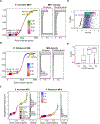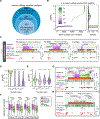Supersaturation mutagenesis reveals adaptive rewiring of essential genes among malaria parasites
- PMID: 39913589
- PMCID: PMC12131478
- DOI: 10.1126/science.adq7347
Supersaturation mutagenesis reveals adaptive rewiring of essential genes among malaria parasites
Abstract
Malaria parasites are highly divergent from model eukaryotes. Large-scale genome engineering methods effective in model organisms are frequently inapplicable, and systematic studies of gene function are few. We generated more than 175,000 transposon insertions in the Plasmodium knowlesi genome, averaging an insertion every 138 base pairs, and used this "supersaturation" mutagenesis to score essentiality for 98% of genes. The density of mutations allowed mapping of putative essential domains within genes, providing a completely new level of genome annotation for any Plasmodium species. Although gene essentiality was largely conserved across P. knowlesi, Plasmodium falciparum, and rodent malaria model Plasmodium berghei, a large number of shared genes are differentially essential, revealing species-specific adaptations. Our results indicated that Plasmodium essential gene evolution was conditionally linked to adaptive rewiring of metabolic networks for different hosts.
Conflict of interest statement
Figures







Comment in
-
Not just monkey business.Science. 2025 Feb 7;387(6734):582-583. doi: 10.1126/science.adv2328. Epub 2025 Feb 6. Science. 2025. PMID: 39913602
References
-
- World malaria report 2021 (9789240040496 (electronic version) 9789240040502 (print version), 2021. https://iris.who.int/handle/10665/350147).
-
- World malaria report 2022 (9789240064898 (electronic version) 9789240064904 (print version), 2022. https://iris.who.int/handle/10665/365169).
MeSH terms
Substances
Grants and funding
LinkOut - more resources
Full Text Sources
Molecular Biology Databases

